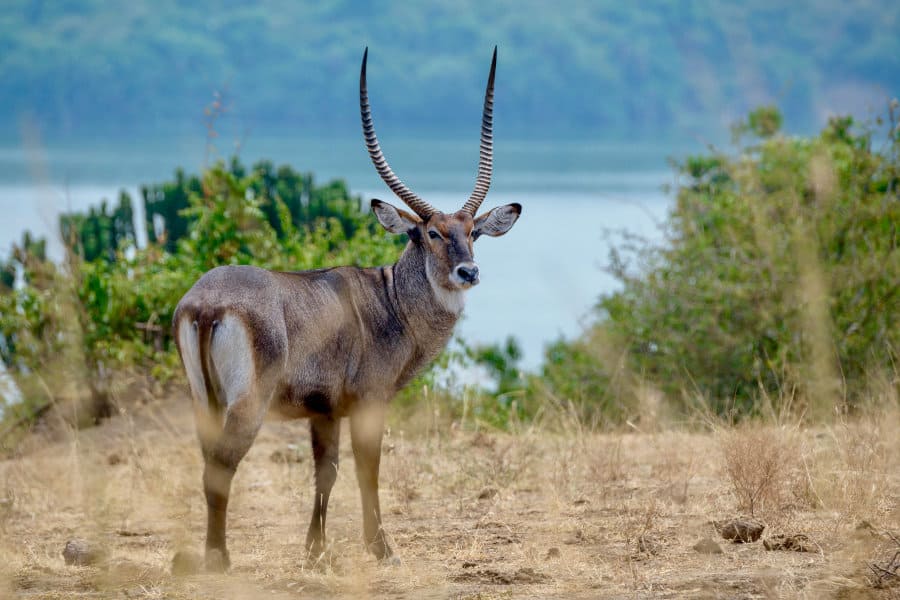Among Africa’s most well-known antelope, the waterbuck is always near the top of the spotting list. The aptly named common waterbuck is the best known of two species. The other is the defassa waterbuck, mostly seen in the Serengeti and Masai Mara region.
The common waterbuck bears a “Concerned” status attached by the International Union for Conservation of Nature. It is nonetheless a wonderful and regular sight on safaris in southern Africa. Let’s find out more about this pretty beast.
What is a Common Waterbuck?
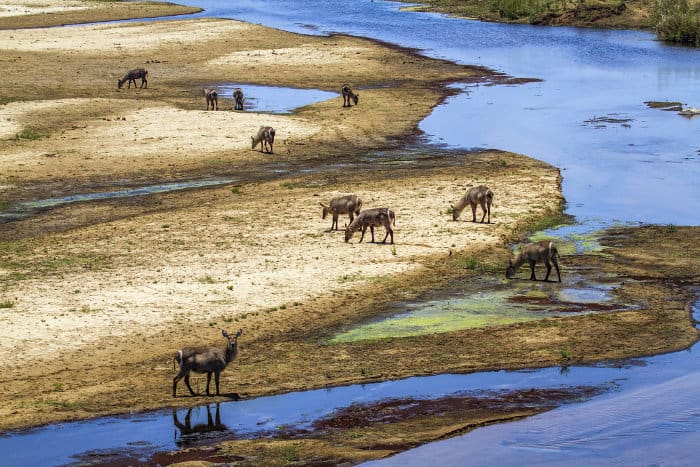
Kobus ellipsiprymnus – that’s the scientific name – is an antelope found largely in southern Africa. It bears a distinctive white circle on its rear. They are usually seen around water sources, in open grassland and on floodplains.
Waterbucks are brown, some with a grey tint, with white markings around the eyes and nose. There is also a white collar section prominent on the front of the neck. Males have long, ringed horns.
Male and Female Common Waterbuck Comparisons
The common waterbuck is a sexually dimorphic species – in effect: males are typically bigger than females. A full-grown male can weigh as much as 270 kg (600 lbs), while a large female comes in at 240 kg (530 lbs).
Males are also taller, standing around 130 cm (50”) at the shoulder. Females are slightly shorter. They are typically around 10-15 cm (5”) shorter on average.
The beautiful horns of a male waterbuck can be as long as 100 cm (40”).
Is the Common Waterbuck a Deer?

In basic terms, deer antlers are branched “headgear” that shed every year, while antelope horns do not branch and are permanent.
Common waterbuck have horns, and they are therefore antelope, not deer. In some antelope, females also have horns, though theirs are smaller. Female common waterbuck, however, do not have horns.
Social Behaviour of the Common Waterbuck?
Common waterbuck are social animals. They live in herds or groups of up to 12. Male antelope are dominant over a certain territory, and their herd consists of females, young bachelors and calves.
The herds are constantly changing, as individuals can join or leave at any time, provided there aren’t other males looking to dominate the territory.
These other breeding males stay apart from the herd. They will also stay out of the area in general. When bachelors congregate in groups, they will also vie for dominance in that group.
When a bachelor threatens the territory of a herd leader, the dominant male will posture aggressively and even start a fight if necessary. These fights can be fatal, as the waterbuck uses its long, strong horns in combat.
The presence of a breeding-age bachelor doesn’t always result in a fight, though. If he is simply moving through a territory, a young male may act submissive. The dominant waterbuck will accept this – for a while.
Common Waterbuck Speed
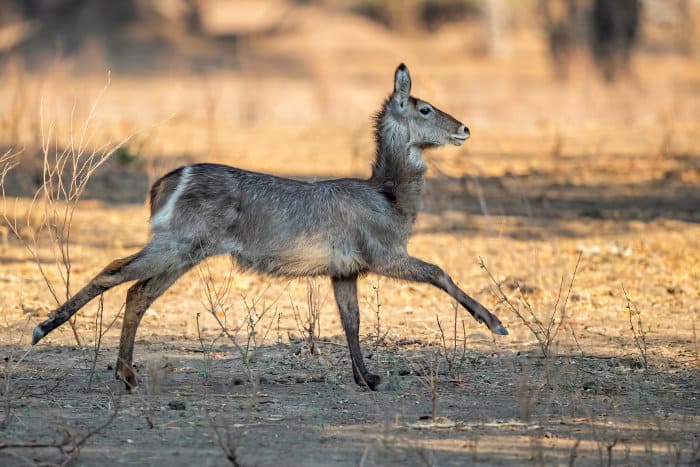
Waterbuck are much thicker than impala and most other antelope. In fact, they are physically more comparable to a lechwe or puku. If chased, they can reach up to 50 km/h (31 mph).
This isn’t among the fastest African antelope. For comparison, Tsessebe – the fastest antelope – is recorded hitting 90 km/h (56 mph). And the popular impala registers at 80 km/h (50 mph).
South Africa’s own springbok (the animal, not the rugby player) slips in there at 88 km/h (55 mph).
Who are the Common Waterbuck’s Predators?
A slow waterbuck is a potential target for Africa’s top predators. These top hunters make up most of the waterbuck’s potential predators. Lions, leopards, hunting dogs and hyenas are common culprits.
Because they’re always near water, they are prey for crocodiles, too. And they are no match for the speedy cheetah, which can outrun most prey animals it encounters, anyway.
How Does the Common Waterbuck Escape Predators?
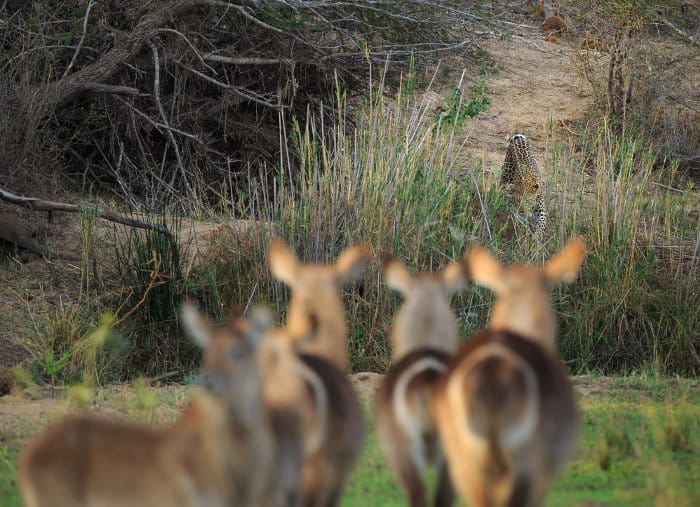
That said, waterbuck are not totally helpless against those predators. When a predator is not a water-borne creature, the waterbuck will happily take to the water to escape its enemy.
Otherwise, they look to hang around in the thick brush, hiding from unwanted attention, and avoiding the need to run out on the open ground.
Some local wisdom dictates that waterbuck meat tastes bad, and some predators avoid them. Science is unclear on whether or not this is true. The animal does secrete an unpleasant-smelling odour from its sweat glands. At the very least, humans have reported the taste of waterbuck meat to be unpleasant.
What Does the Common Waterbuck Antelope Eat?
Favourite food includes long grass, and they are happy to munch on rough vegetation. They may also eat some fruit and seeds, and seem to share a love of marula with elephants.
Most importantly, waterbuck will never be far from water for drinking. The juicy water plants make for great eating as well.
Gestation of the Common Waterbuck

A female waterbuck gestates for up to eight months, and gives birth to a single calf. When she is ready to deliver, the waterbuck will typically separate from the herd and find a well-hidden spot to give birth.
She will stay here with the newborn calf for about a month before rejoining the herd. Mothers are fiercely protective of their calves.
Common Waterbuck Lifespan
After joining a herd with their mothers, calves wean for around eight months. They then join a sub-herd of their peers (age-wise).
Typically, a waterbuck will live up to 18 years in the wild. In general, 12-15 years is a good life for a wild waterbuck. Some records show that this can extend to almost 30 years in protected captivity.
More Weird Waterbuck Animal Facts
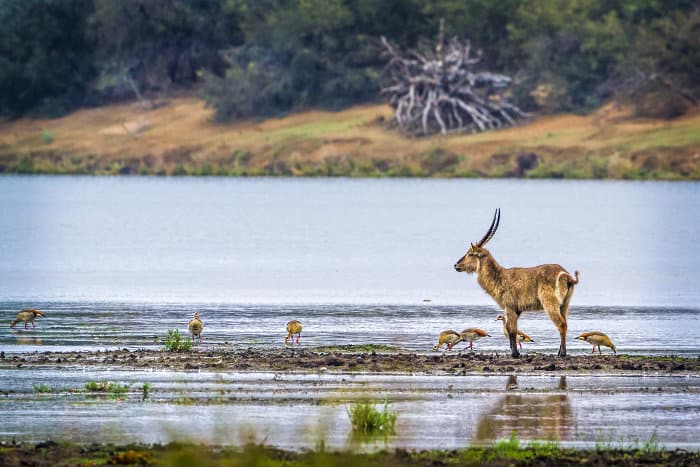
Here are a few more random waterbuck facts:
- The ring around their bottoms helps a group stay together, especially when a herd is in flight.
- A young male may get a free pass from a dominant male, if it helps with protecting the dominant’s territory.
- When an alpha male is showing dominance, it will either stand front-on, showing its neck and horns, or sideways, showing its size.
- They are great swimmers, even if they don’t do it regularly.
The Future of the Common Waterbuck Antelope
And that’s the story of a common waterbuck in Africa. With all of that said, there’s nothing that can compare to seeing them in the wild, along with the other animals mentioned here. Why not go on an African safari yourself and see them in person?

